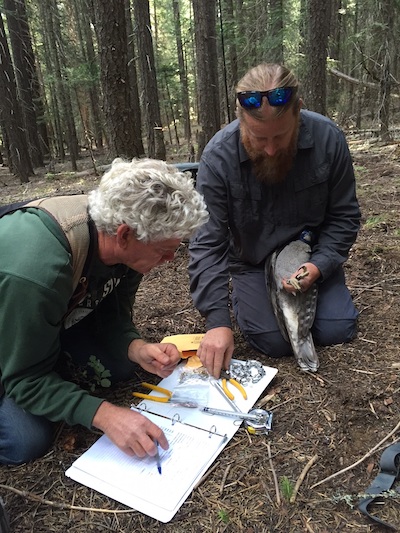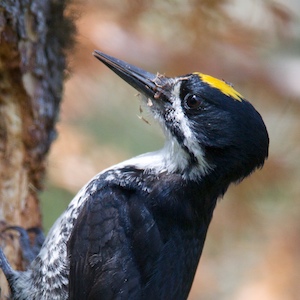Wildfire is a natural process in the forests of the western US, and many species have evolved to tolerate, if not benefit from it. But wildfire is changing. As fires become more frequent and severe, they may pose risks to species like the Northern Goshawk. New research published in the journal Biological Conservation suggests fire poses substantial risk to goshawks in the Sierra Nevada region.
Dr. Rachel Blakey and her colleagues at The Institute for Bird Populations collaborated with scientists from the U.S. Forest Service and the U.S. Geological Survey Missouri Cooperative Fish and Wildlife Research Unit at the University of Missouri to investigate habitat preferences of Northern Goshawks in relation to fire in the Plumas National Forest in California. The researchers fitted 20 Goshawks with solar-powered global positioning system (GPS) tracking devices and monitored which habitats the birds chose for foraging and night-time roosting. Goshawks preferred older, more mature forest stands for both activities, and a further analysis showed the majority of this roosting and foraging habitat is at high risk of severe wildfire.

Colin Dillingham and Jeff Kidd band a Northern Goshawk before release. Photo courtesy of Colin Dillingham.
How Northern Goshawks respond to fire is not well understood. The one study to date showed that high severity fire tended to displace nesting goshawks. This makes sense because goshawks in western forests are known to nest in dense, mature forest, which is destroyed by high severity fire. But the effects of fire on the birds' roosting and foraging habitat may be more complex, as prey populations may temporarily increase in burned areas and improve their quality as foraging habitat.
Most studies of habitat preferences in goshawks have focused on the nest site. Likewise, most management efforts to conserve goshawks are centered on the nest. But Blakey notes that "to effectively manage and conserve wildlife, we need to understand how animals use the landscape across their life cycle." The advent of lightweight tracking devices, like the ones used in this study, has allowed scientists to better understand how birds like Northern Goshawks use habitat for activities beyond nesting.
In this study, the researchers compared the habitat goshawks actually used for roosting and foraging to the habitat available to them in the study area. This allowed the researchers to evaluate which characteristics, such as canopy cover, tree size, and fire history were preferred.
Goshawks preferred forest stands with larger, more mature trees and higher canopy cover–also called "late seral" forest–for both roosting and foraging. Fewer than six percent of roosting locations were in forest that had been burned in the last 50 years. The birds also avoided foraging in areas that had been burned at high severity.
"While there was individual and sex-based variability in selection of habitat at the finest scales," says Blakey, "at the larger spatial scales that are arguably most important for management, goshawks consistently selected for late-seral forest."
Unfortunately, late-seral forest is already in short supply in the western US and the attributes that make it attractive to Northern Goshawks also put it at a high risk of large and severe wildfires.
"A lot of work by our organization and others over the past decade has shown that some wildlife species are quite resilient to forest fire and can even thrive in recently burned forests," says Rodney Siegel, Executive Director of The Institute for Bird Populations and co-author of the study, "But habitat selection by the Northern Goshawks we studied suggests that these birds, with their strong preference for late seral forest attributes like big trees and closed forest canopy, are jeopardized by changing fire patterns that reduce forest cover.”

Scott Thomas prepares to release a Northern Goshawk.
Indeed, the researchers found that majority of roost sites and foraging habitat in their study area was designated a "High Wildfire Potential Hazard" by the U.S. Forest Service. Approximately 80% of foraging space and 87% percent of roost sites were at high risk of fire.
But reducing this risk will be tricky. Siegel notes, "a major challenge for forest managers is that treatments to reduce risk of high-severity fire, including forest thinning and prescribed fire, may also reduce goshawk foraging and roosting habitat quality if they decrease canopy cover and fragment late-seral forest."
The researchers suggest that using these treatments primarily in middle-aged or young forest stands may reduce risk of large high severity fires while conserving the mature, dense forest preferred by goshawks.
Blakey expects that the foraging and roosting habitat preferences seen in goshawks in this study are probably common to goshawks throughout the Sierra Nevada region, and perhaps western montane forests in general. Likewise, this preferred habitat is likely at risk of high severity fire across the region as well. "Given that fire regimes are changing across the range of the Northern Goshawk, both in the U.S. and across the species' distribution globally," says Blakey, "use of burned habitats by this species should also be investigated more broadly."






